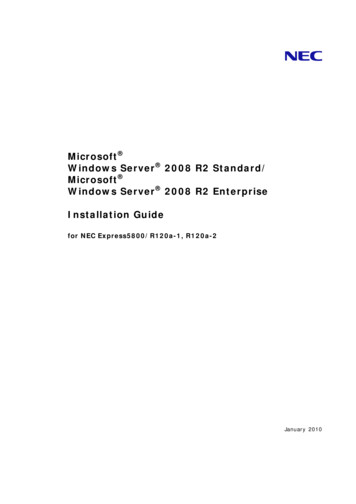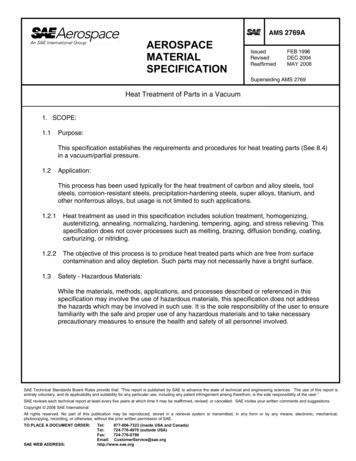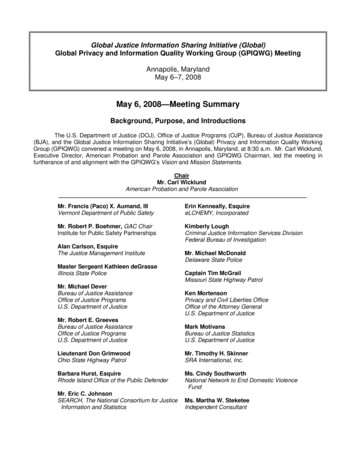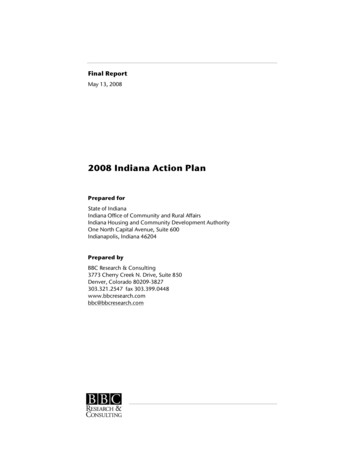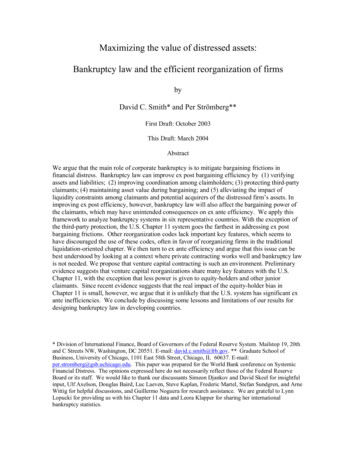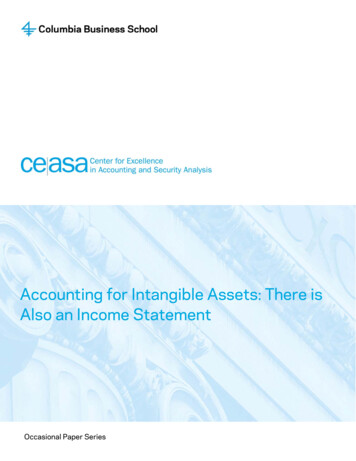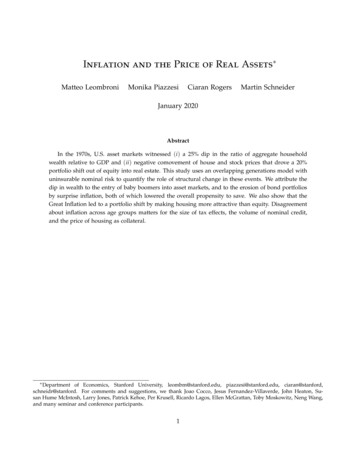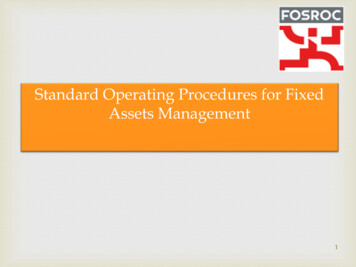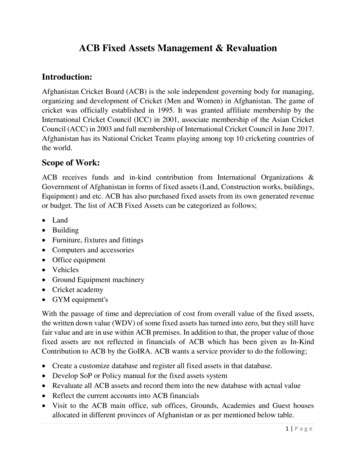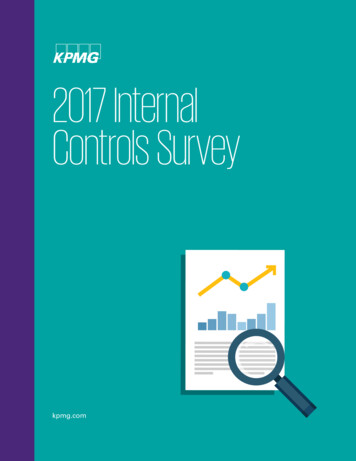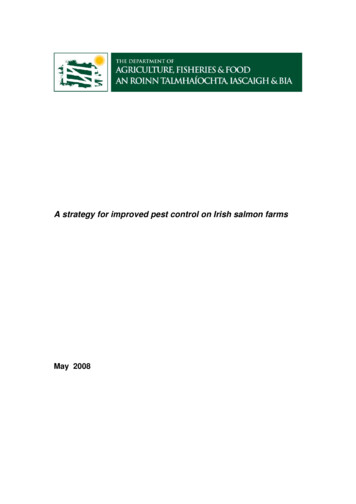
Transcription
A strategy for improved pest control on Irish salmon farmsMay 2008
Executive SummaryMarine finfish production in Ireland grew steadily throughout the 1990s;production in 2001 reached a high point of 24,000 tonnes but declined to13,318 tonnes by 2006, due in some part to a lack of profitability andconsequent liquidity in the sector. 2007 saw a small increase in productionlevels to 13,800 tonnes. The Minimum Import Price (MIP), a trade correctionmeasure introduced by the European Union in 2005, has stabilised farmedsalmon prices in a market which was being distorted by below-cost-selling inthe European market. The MIP has provided the Irish industry with anopportunity to trade its way back to prosperity and to a position where it canonce again increase output. The Irish industry acts as an important socioeconomic driver in a number of rural and coastal communities by providing asource of local employment both full time and seasonal.Farmed salmon is now the most commonly eaten fish in Europe, because ofits year round availability and its versatility from a culinary perspective.The ecto-parasitic sea louse, a tiny crustacean, is an economically significantpest of the farmed salmon industry worldwide. It is important, both from a farmmanagement point of view and in the context of possible negative interactionswith wild migratory salmonid populations, that this pest be tightly controlled.Accordingly, a mandatory national sea lice monitoring and control regimeregime which features so-called ‘treatment-trigger-levels’ has been put inplace, which aims to keep the level of infestation on marine salmon farms aslow as possible. Achieving the desired level of control of this parasite hasproved to be a challenging proposition in some areas in recent yearsThe pest has shown itself to be very resilient and it has the ability to rapidlydevelop resistance to the limited range of veterinary medicines that areavailable to treat it. Levels of infestation were successfully controlled, by andlarge, through the 1990s, but since 2002/2003 it has been more difficult forthe salmon farmers, despite their best efforts, to achieve the very low levels ofinfestation required by the national control programme. The causes of this
difficulty are multifactorial and include: a succession of warm winter seatemperatures, resistance by the pest to the veterinary medicines, limitedaccess to ‘fallowing sites’ for temporal and spatial separation of stocks andother complicating fish health problems.The control of sea lice has been afforded a high priority by the State since1991 and Irish salmon farms are the subject of a rigorous and transparentinspection regime carried out by the Marine Institute on behalf of theGovernment.This monitoring programme is backed up by mandatorylicensing requirements imposed on fin-fish farmers through a protocol onmanagement and control.A Sea Lice Monitoring and Control Working Group was established by thethen Department of Communications, Marine and Natural Resources in 2005,comprised of representatives of the Department, the Fisheries Boards, MarineInstitute and an Bord Iascaigh Mhara to examine/review the systems andprocesses for controlling sea lice levels at marine finfish farms. The Group’sdeliberations were wholly inconclusive and it was unable to reach anyconsensus on the way forward at the time of the transfer of aquaculturelicensing functions to the Department of Agriculture, Fisheries and Food.Since the establishment of the new Department of Fisheries, Agriculture andFood (DAFF) the Department and the Marine Institute have continued to workon the issue of enhanced sea lice control.The following report outlines a comprehensive range of measures to providefor enhanced sea lice control.The report makes the following recommendations:1.A joint DAFF/industry working group to be establishedto identify“break out” site options in areas which have persistent sea lice problems.These options would include the possibility of using redundant sites, tooptimise fallowing and separation of generations.2.Effective and appropriate use of chemical intervention to be reviewedto take ongoing account of changing environmental conditions, developingfarming practices, sensitivity of lice to treatments and fish health issues.
3.The increased availability of well boat capacity coming on stream in theindustry to be utilised for controlled bath treatments.4.The optimisation of product rotation for strategic treatments should begiven further consideration as a matter of urgency.5.BIM and the Marine Institute to engage in intensive consultation withthe fish farming industry, both with individual fish farmers and representativeorganisations, to ensure ongoing optimisation of management practices andto report back to the Minister within four months.6.BIM and the Marine Institute to immediately establish a working groupto report in three months on the potential of alternative treatment approachesand to set out the steps necessary to introduce these approaches.7.A national implementation group to be established comprisingappropriate representation from:The Coastal Zone Management, Veterinary and Seafood Policy Divisions ofthe Department of Agriculture, Fisheries and Food;An Bord Iascaigh Mhara;Marine Institute; andIndustry representatives.The group is to provide the Minister, within six months of it’s establishment,with a full update of the actual situation on the ground, the progress made toreduce sea lice levels and the further steps required, if any, to redress thesituation.8.A New role for SBM (Single Bay Management) as a focus formanagement cells to manage sea lice control at a local and regional levelreporting to the national implementation group.
Table of ContentsSection 1: Background .11.1.Marine Finfish Aquaculture in Ireland .11.2An Overview of the Challenges facing the industry .51.3What are Sea Lice? .61.4What effect do sea lice have?.6Section 2:Sea Lice Monitoring .82.1Background .82.2Purpose of Monitoring.92.32007 Trends .102.4Annual Trends .122.5Management Strategy .132.6Trigger Levels for Treatment .142.7Sampling Strategy .15Section 3:Co-ordinated Management Systems.173.1.Single Bay Management.173.2.CLAMS .173.3Fallowing .18Section 4:The Problem in Context .214.1Best Practice .214.2Causes of Current Difficulty .224.3Potential Alternative Method of Treatment.224.4Review of lice control methods .244.5Solutions / Response Options .26Section 5:Conclusions .27Section 6. Recommendations and Action Plan .28Appendices.33
Section 1: Background1.1.Marine Finfish Aquaculture in IrelandIn the global context, aquaculture has grown significantly over recentdecades, with annual growth of the order of 10% since 1990. It is the fastestgrowing area of food production. The industry is also characterised byongoing diversification and innovation, including the cultivation of newspecies.Salmon farming started in Ireland commercially in or around 1978. The firstsignificant company was Curraun Fisheries Ltd (at the time a wholly ownedsubsidiary of Guinnesss Ireland Plc). There was a debate for a few years as towhich species (Atlantic salmon or Rainbow trout) would be the more suitablefor cultivation, with salmon winning out eventually as their survival at sea wasbetter and they fetched a higher price. Roughly 350 tonnes of farmed salmonwere produced in 1980 at a value of about 2.6million (prices were very highat that time as the fish were a rarity).Since its initial trial development in the early 1970s, the Irish industry hasgrown to become a significant contributor to local economies.The Irishaquaculture industry provides fulltime and part time employment for some2,000 people and had a value in 2007 of 131m.salmon in 2007was estimated at 13,800 tonnes.Production of farmedBIM estimated that 410people were employed in finfish farming during 2005, of which 247 were fulltime.Irish output, however, is tiny by international standards.By way ofcomparison the two main world producers of farmed salmon, Norway andChile, accounted for production of approximately 670,000 tonnes RWE 1 andapproximately 660,000 tonnes RWE respectively, in 2006.Scotland thenearest salmon farming country had an output of about 150,000 tonnes RWEin 2006. Thus the Irish sector is less than one eleventh the size of its nearestneighbour and about one fiftieth the size of its main competitors.1Salmon production is given as Round Weight Equivalent – i.e. the harvest weight of the fishafter is has been starved and bled.-1-
There are three distinct regions in Ireland where marine salmonid farming iscarried out, illustrated on the maps (courtesy of the Marine Institute)below:The West (Counties Mayo and Galway),Salmon farm sites in south ConnemaraSites used in 2006 z redSites not used in 2006 zorange-2-
Salmon farm sites in Mayo and north ConnemaraSites used in 2006 z redSites not used in 2006 zorange-3-
Salmon farm sites in the Southwest (Counties Cork and Kerry)Salmon farm sites in the Northwest (Co. Donegal)Sites used in 2006 z redSites not used in 2006 zorange-4-
Finfish production in Ireland grew steadily throughout the 1990s; production in2001 was as high as 24,000 tonnes but declined to c.12,000 tonnes by 2006 2 .The Cawley Report (Steering a New Course – Strategy for a Restructured,Sustainable and Profitable Irish Seafood Industry 2007-2013) identifiedmarket factors (salmon prices earlier this decade plummeted due to belowcost selling) as the dominant cause for the decline. The European Unionintroduced Minimum Import Prices in 2005 and farmed salmon prices havestabilised significantly since then.The Cawley Report also noted that sub-optimal stock performance due to fishhealth problems had also had a negative impact on the Irish industry. Thereport cites recent improvements in husbandry, stock breeding and feedingpractices as the basis on which this issue is being addressed. The reportacknowledges that in recent years the Irish industry has not been an attractiveinvestment option, owing to the foregoing difficulties and also to shortcomingsin the regulatory framework.1.2An Overview of the Challenges facing the industryThe biggest challenges facing the Irish salmon farming industry, as identifiedby the Cawley Report, revolve around the issues of public acceptance,proportionate regulation and the efficient control of pests and other fish healthproblems. At a national level, there is a concerted effort underway abetterunderstanding of the sector and its importance. At a local level, in manyareas, the CLAMS process (Co-ordinated Local Aquaculture ManagementSystem) and the SBM (Single Bay Management) scheme approaches arebeing used to address these challenges.Marine finfish farms are also perceived by anglers and wild fisheries intereststo be problematic because of the proximity of some operations to river mouthsand a concern over the possible impact on wild migratory salmonid fisheries.The Irish salmon farming industry has, for some time, expressed the need for2Browne R, Deegan B, O’Carroll T, Norman M and Ó Cinnéide M. 2007. Status of IrishAquaculture 2006. Merc Consultants-5-
the provision of more sites for fallowing and separation of generationspurposes. However, new applications have been slow to come forward inrecent years, possibly due to the complex nature of the licensing process anduncertainties associated with the aquaculture licence appeals process.However, there are a number of underutilised licensed sites which are thoughtto hold significant break out potential for current operators. The use of thesesites by existing operators to separate generations of fish and facilitate bettermanagement practices has begun to emerge.1.3What are Sea Lice?Sea lice are a group of parasitic copepods found on fish world wide. There aretwo species of sea lice commonly found on cultured salmonids in marineconditions around the coast of Ireland, Caligus elongatus Nordmann, whichinfests over eighty different species of marine fish, and Lepeophtheirussalmonis Krøyer (the salmon louse), which infests only salmon, trout andclosely related salmonid species. L. salmonis, the salmon louse, is the moreserious parasite on salmon, both in terms of its prevalence and effects. It hasbeen reported as a common ecto-parasite of both wild and farmed salmon atsea.Returning wild salmon have been found to carry an average of 10 or moreadult egg bearing females on their return to the Irish coastline from theirfeeding grounds in the Atlantic. Having evolved their relationship with salmonand trout over many millennia, the parasite is extremely well adapted to targetits host species and it is ubiquitous to all the coastal waters around Irelandand indeed throughout the range of the Atlantic salmon.Salmon, whether wild or cultured, go to sea from fresh water free of sea liceand only pick up the infestation after they enter the marine phase of their lives.1.4What effect do sea lice have?Sea lice infestations can have commercially damaging effects on culturedsalmon. They inflict damage to their hosts through their feeding activity on theoutside of the host's body. Sea lice affect farmed salmon stock by damagingthe integrity of the fish’s epithelium, which impairs its osmoregulatory ability-6-
and leaves the fish open to secondary infections. The net effect of infestation,especially if it is left unchecked, is a reduced growth rate and an increasedmorbidity.Sea lice and sea lice infestation of salmon have no implications forhuman health or seafood safety.-7-
Section 2: Sea Lice Monitoring2.1BackgroundMonitoring of lice infestation levels on salmonid farms in Ireland was initiatedin April/May 1991. This was in response to concerns that lice emanating fromfarmed salmonids might be implicated in the phenomenon of large numbers ofsea trout returning to rivers in early summer in an emaciated state and withelevated lice numbers. Since April 1994, monitoring has been carried out inaccordance with the recommendations of the Sea Trout Task Force and itssuccessor body, the Sea Trout Management and Advisory Group.The current national sea lice monitoring programme involves the inspectionand sampling of each year class of fish at all fish farm sites 14 times perannum - twice per month during March, April and May and monthly for theremainder of the year except December-January. Only 1 inspection is carriedout during this period.In the early phases, the level of lice per fish that would trigger the need fortreatment was set at a level of 2.0 lice per fish during the Spring period fromMarch to May. These trigger levels have been tightened up over the years,however, as the monitoring and control programme has been developed andenhanced and incorporated into the existing Monitoring Protocol.In 2000 this monitoring regime was formally adopted as one of a number ofMonitoring Protocols to which all salmon farmers are required to adhere. Theinspections are carried out directly by the Marine Institute (MI).Thisprogramme is applied at all marine finfish farms regardless of whether thelicensee, through the terms and conditions of it’s licence, is subject to theterms of the Protocol or not. The cooperation of the industry in this respect isnoted. A copy of the Sea Lice Monitoring Protocol is attached at Appendix 1.-8-
Lice levels are determined from the sampling process and measured againsttarget levels set out in the protocol or in licences.The Spring period (Marchto May) targets are now set at very rigorous levels of 0.3 to 0.5 egg bearing(ovigerous) lice per fish. Outside of this a level of 2.0 egg bearing lice acts asthe trigger for treatment. Where measurements at a farm exceed these targetlevels the MI issues a “Notice to Treat” to the licensee.Results are reported to farms by the MI within five working days of theinspection together with appropriate advice. Monthly reports are compiled foreach site of mean numbers of egg bearing lice and total mobile lice of eachspecies. These reports are circulated to the farms, the Department, theMarine Institute, the Central Fisheries Board, the Regional Fisheries Boards,the Irish Salmon Growers Association, Save Our Seatrout and the WesternGamefishing Association. This ensures that real time information on the levelspertaining on farms is available to all interested parties. These reports aredesigned to give a clear, unambiguous measure of the infestation level ateach site and to act as a basis for management decisions.2.2Purpose of MonitoringThe initial purpose of the monitoring in 1991 and 1992 was to obtain anobjective assessment of infestation levels on farms and to investigate thenature of these infestations. The results of these investigations, first publishedin 1993, were used to develop a management strategy for effective sea licecontrol and subsequently to refine and further enhance the managementstrategy. The purpose of the national sea lice-monitoring plan since 1994 hasbeen: To provide an objective measurement of infestation levels on farms To investigate the nature of the infestations To provide management information to drive implementation of thecontrol and management strategies To facilitate further development and refinement of the control andmanagement strategies.-9-
2.32007 TrendsAppendix 2 contains key information on sea lice infestation during 2007. Thestatistics in the tables are presented on a site by site and regional basis. Forthe purposes of this report the key issues to note are as follows:2005 salmonOnly 4 sites (west & north—west) contained two sea winter salmon (i.e.salmon that had been at sea during winter 05/06 and winter 06/07) in 2007.Of these 4 sites, 3 sites had 100% of samples above the trigger levels oninspection.The number of such inspections is small however as these fishwere harvested by March 2007 at the latest.2006 salmonSouth-West-only 1 site (Roancarraig, Bantry Bay) was stocked-all 6 samples in the critical spring period exceeded the treatmenttrigger levels-sea-lice levels continued to increase during the critical period,notwithstanding the application of treatmentsWest-there was a further reduction in the number of sites stocked in 2007(11) compared with 2006 (18)-of
A strategy for improved pest control on Irish salmon farms . May 2008 . Executive Summary . Marine finfish production in Ireland grew steadily throughout the 1990s; production in 2001 reached a high point of 24,000 tonnes but declined to 13,318 tonnes by 2006, due in some part to a lack of profitability and
